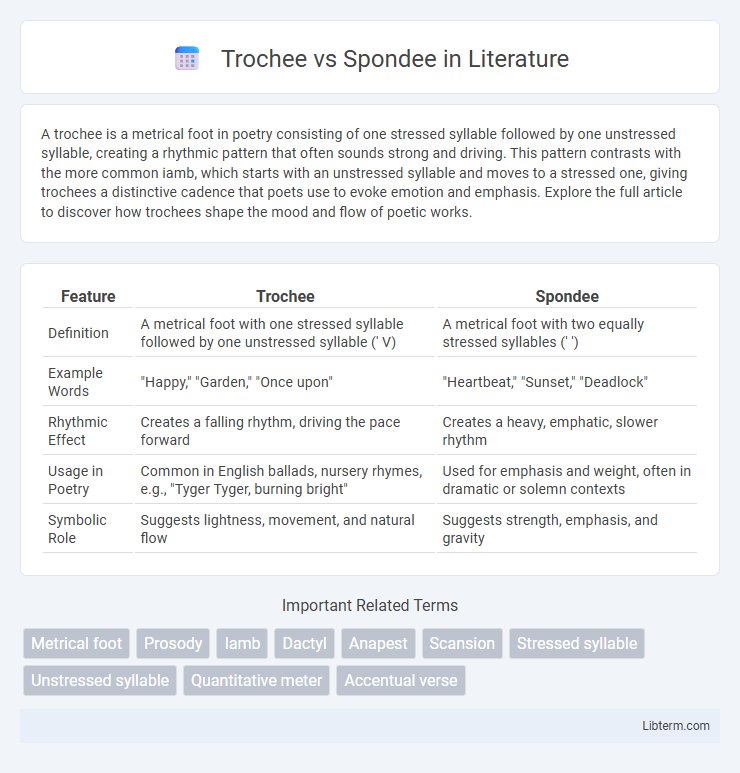A trochee is a metrical foot in poetry consisting of one stressed syllable followed by one unstressed syllable, creating a rhythmic pattern that often sounds strong and driving. This pattern contrasts with the more common iamb, which starts with an unstressed syllable and moves to a stressed one, giving trochees a distinctive cadence that poets use to evoke emotion and emphasis. Explore the full article to discover how trochees shape the mood and flow of poetic works.
Table of Comparison
| Feature | Trochee | Spondee |
|---|---|---|
| Definition | A metrical foot with one stressed syllable followed by one unstressed syllable (' V) | A metrical foot with two equally stressed syllables (' ') |
| Example Words | "Happy," "Garden," "Once upon" | "Heartbeat," "Sunset," "Deadlock" |
| Rhythmic Effect | Creates a falling rhythm, driving the pace forward | Creates a heavy, emphatic, slower rhythm |
| Usage in Poetry | Common in English ballads, nursery rhymes, e.g., "Tyger Tyger, burning bright" | Used for emphasis and weight, often in dramatic or solemn contexts |
| Symbolic Role | Suggests lightness, movement, and natural flow | Suggests strength, emphasis, and gravity |
Introduction to Trochee and Spondee
Trochee is a metrical foot consisting of a stressed syllable followed by an unstressed syllable, commonly found in English poetry to create a rhythmic and flowing effect. Spondee, by contrast, features two consecutive stressed syllables, often used to emphasize a strong beat or convey urgency in verse. Both trochee and spondee are fundamental components of prosody, shaping the natural cadence and emotional tone of poetic lines.
Defining Trochee: Structure and Examples
A trochee is a metrical foot consisting of one stressed syllable followed by one unstressed syllable, creating a falling rhythm pattern commonly used in poetry and verse. Examples of trochaic words include "garden," "hammer," and "window," where the emphasis is on the first syllable. This structure contrasts with other metrical feet, emphasizing a strong initial beat that shapes the cadence of lines in poetry like Henry Wadsworth Longfellow's "The Song of Hiawatha."
Understanding Spondee: Structure and Usage
A spondee is a metrical foot consisting of two consecutive stressed syllables, creating a slow and emphatic rhythm often used to convey strong emotions or highlight important words. Unlike the trochee, which has a stressed syllable followed by an unstressed one, the spondee's equal stress pattern intensifies the mood and adds dramatic weight to poetry and prose. Commonly found in classical poetry and English verse, spondees punctuate lines for emphasis or to break the regular metrical pattern, enhancing the expressive power of the text.
Historical Origins of Trochee and Spondee
Trochee and spondee originated from Ancient Greek and Latin prosody, where trochee consisted of a stressed syllable followed by an unstressed one, often used in lyrical and dramatic poetry. Spondee, characterized by two consecutive stressed syllables, played a crucial role in epic and ceremonial verse, emphasizing solemnity and grandeur. Both metrical feet shaped classical poetry's rhythmic patterns, influencing later European poetic traditions.
Trochee vs Spondee: Key Differences
Trochee and spondee are poetic meters distinguished by stress patterns: trochee consists of a stressed syllable followed by an unstressed one (e.g., "garden"), while spondee features two consecutive stressed syllables (e.g., "heartbreak"). Trochees create a rhythmic, falling emphasis often used to convey a lively or melodic tone, whereas spondees introduce a heavy, forceful beat that emphasizes intensity or urgency. Understanding these key differences enhances the analysis of poetic rhythm and emotional impact in verse composition.
Common Applications in Poetry
Trochee and spondee are metrical feet frequently utilized in poetry to create distinct rhythmic patterns and emphasize emotional tones. Trochees, consisting of a stressed syllable followed by an unstressed one, often appear in nursery rhymes, limericks, and hymns to produce a lively and hypnotic beat. Spondees, with two consecutive stressed syllables, are strategically placed in lines of epic poetry and dramatic verse to intensify mood, add weight to important phrases, and slow the rhythm for dramatic effect.
Trochee in Famous Literary Works
Trochee, a metrical foot consisting of a stressed syllable followed by an unstressed one, appears prominently in famous literary works like Edgar Allan Poe's "The Raven," where the rhythm creates a haunting, melodic effect. This trochaic meter often builds a rhythmic intensity that emphasizes mood and tone, contrasting with the evenly stressed spondee used to convey weight or solemnity in poetry. Trochee's distinctive pattern drives memorable lines and enhances the emotional resonance in classical and modern poetry alike.
Spondee in Classic and Modern Literature
Spondee is a metrical foot consisting of two stressed syllables, often used to emphasize rhythm and create a deliberate pace in both classic and modern literature. In classic poetry, spondees are employed to highlight solemn or dramatic moments, enhancing the gravity of epic narratives such as Homer's Iliad. Modern writers utilize spondaic meter sparingly to disrupt regular patterns, intensifying emotional impact or drawing attention to key themes within free verse and contemporary poetry.
How to Identify Trochees and Spondees
To identify trochees, look for metrical feet consisting of a stressed syllable followed by an unstressed syllable, as in words like "garden" or "happy." Spondees feature two consecutive stressed syllables, found in compound words or phrases such as "heartbeat" or "dead set." Scanning poetry by marking stressed and unstressed syllables helps distinguish trochees from spondees within the rhythm and meter of the text.
Enhancing Poetry with Metrical Variation
Trochee and spondee meters enhance poetry by introducing rhythmic diversity and emotional emphasis; trochee, with its stressed-unstressed pattern, creates a lively and dynamic flow, while spondee's double stress slows the pace for dramatic impact. Integrating trochees can invigorate a poem's cadence, breaking monotony of iambic lines, whereas spondees reinforce key words or themes, heightening tension or gravity. Effective use of these metrical feet enriches poetic texture, balancing rhythm and meaning to captivate readers.
Trochee Infographic

 libterm.com
libterm.com